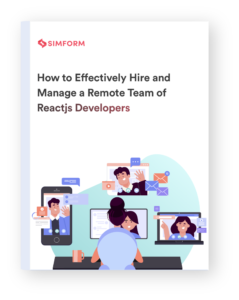An In-Depth Guide To Hiring React Native Developers
While it is said that every successful business starts with an idea, what they do not mention is the fact that those same ideas have to be implemented flawlessly to get the desired results. The concept resonates more within the software development industry because only a functional and responsive application can get users’ attention.
Speaking of responsive applications, React Native has always been the most favored choice among developers. If we go by numbers, 42% of total developers worldwide prefer to build native-like mobile apps using React Native.
Some of the most successful implementations of React Native applications include Bloomberg, Facebook, Airbnb, Uber Eats, Instagram, Discord, and many more. The apps owe their success to this cross-platform framework’s development cost, speed, high-performance solutions, and endless possibilities of creating a rich user interface.
But simply choosing React Native as your preferred platform does not guarantee the success of your application. After all, it is the developer who would be in charge of shaping your dream project. And, if you’re planning to hire a React Native developer, some questions are bound to occur, for example,
- How do we choose the right React Native developer?
- How many years of experience should they have?
- What skill sets must they possess?
Keeping some of these questions in mind, we’ve created this quick reference article. So let us start addressing such questions and help you better understand when it comes to hiring React Native developers.
Responsibilities of a React Native Developer
One of the primary responsibilities we expect from every developer is to write clean codes for obtaining the smooth performance of an application. But, being skilled enough to write clean code is not enough. Irrespective of the experience a React Native developer might possess, a list of responsibilities must be laid out for prospective developers to understand what would be expected from them while developing a mobile app.
Here is a list of some basic responsibilities of a React Native developer.
- Create seamless native-like UI for Android and iOS mobile platforms.
- Translating client requirements into clean, reliable, and maintainable codes.
- Monitoring performance gaps and identifying errors in user experience before they appear.
- Conducting automated tests and performance checks to maintain application quality.
- Flexibility in employing native APIs for integrating external tools and libraries across cross-platform apps.
- Adhering to the full-stack development process laid out as per company standards and expectations.
10 Things to Remember While Hiring a React Native Developer
Technical knowledge and experience are the primary factors determining whether a developer is proficient enough with React Native. Now that you have some idea about the basic responsibilities of a React Native developer, it’s time to focus on the necessary skills they must possess.
1. How proficient are they with JavaScript?
JavaScript is the fundamental language based on which React Native functions for creating cross-platform mobile applications. Developers must have knowledge and proficiency of JavaScript ES6 and later, including its features and enhancements. The skills and domain experience of JavaScript opens up the possibility to build interactive UI components and structuring application logic at an infrastructural level.
2. Are they aware of React Native concepts and their functionalities?
Familiarity with React Native framework is one of the key prerequisites to look for while hiring a developing expert. Fundamental concepts like Virtual DOM, JSX, and component lifecycle are like the ABCs of React Native that enhance the User-Interface (UI) and application performance. In addition to that, developers should have a sound understanding of the basics such as customizing and handling the props and state of a React component. The list goes on but possessing the basic knowledge beforehand will help them undergo a steady onboarding and training catered to your project.
3. Can they write clean codes?
Writing clean and understandable code is the foundation for any mobile development process. While potential developers might undoubtedly have the skills to write codes for the application, they must be fully aware of how different classes of codes interact with each other. Developers must strive to add consistent operations to their mobile applications, and it can only be achieved through functional codes. Moreover, monitoring and maintaining application changes at scale can be accomplished only if the React Native developer has the ability to write readable codes.
If you take this trait lightly, you might end up paying through your nose to handle errors and maintenance when the developer ends up writing inconsistent codes. However, mock tests can be conducted for junior and middle-level developers to identify if they can handle React Native-based fragments and events while writing codes.
4. Do they have a familiarity with adjacent tools and technologies?
Familiarity with adjacent technologies is of potential advantage as it gives developers the ability to create scalable mobile apps that can function with other frameworks when needed. State management libraries like Redux, and MobX, offer operational control over the application logic, making apps run as per expectations. Other tools like Enzyme, Hockeyapp, Bower, Gulp, etc., can make performance testing and full-stack development processes quicker. While junior developers might only have an idea or theoretical knowledge of these tools, companies can gain an advantage if they have practical exposure to its usage.
5. Do they have experience with Android and iOS platforms?
One of the advantages of the React Native framework is that it provides a single codebase for both Android and iOS platforms, eliminating the need to develop native applications separately. But, it is always beneficial to hire a developer who has experience in at least one or both platforms to meet changing requirements. A candidate with experience in building mobile apps for different platforms would have practical exposure and an analytical mindset to deal with native-app-related issues. A middle or senior-level React Native developer with hands-on experience with native frameworks like Objective C, Swift, or Andriod Studio would have sufficient knowledge about the intricacies of different platforms.
6. Can they perform debugging and testing of an application?
Application debugging and testing is a periodical task during and post-production that requires special attention. Developers must possess the ability to conduct different variations in testing to ensure that the mobile app does not fail. This is because even the slightest glitch can create a negative impression amongst users and for your business growth. Familiarity with type checking and unit testing tools like Jest, TypeScript, Prop Types, Flow, etc., are considered mandatory for performing the necessary tests.
Potential developers should be able to perform automated tests, indicating their ability to predict application errors. Every testing aspect like security checks, logging, and performance checks are basic activities that a developer must be able to perform.
7. Are they capable of optimizing application performance?
Performance tuning and optimization are critical skills a developer should have to achieve maximum app performance with optimal resource utilization. While no developer would destabilize application performance on purpose, it is all a part of experience and knowledge that allows them to optimize the codes smartly.
A developer who possesses this skill can improve the application speed, loading time, interactivity, and smooth performance irrespective of the user’s device and platform globally. Companies looking for skilled developers who possess optimization talents should look for traits such as handling navigator UI transitions, managing UI drops to reduce animation size, and so on.
8. Can they develop native features for an application?
Delivering a unique user experience through a customized user interface and widgets is the ultimate goal for any good mobile app development project. Such customizations usually involve integrating system resources like the camera, GPS, gyroscope, speakers, and other hardware/ software features. Even though complex in nature, incorporating system resources or platform-specific elements has become part and parcel of every application which provides better accessibility.
Needless to say, there are various complexities involved when hardware features are incorporated into an application. Therefore, to grasp the prospective developer’s ability, the hiring manager can closely look if the applicant has worked on multiple platforms and the level of sophisticated development they can handle.
9. Can they work with third-party dependencies?
One of the advantages of using React Native as a cross-platform framework is that it easily allows third-party tools to be integrated with native features. External API integration enables applications to improve in terms of functionality, accessibility, and rapid updates deployment. In addition, it helps to add premade plugins and widgets instead of building elements from scratch.
Integrating third-party APIs is not as simple as using them. It has to be constantly updated and monitored to look for dependency related-issues within the application. A company looking forward to integrating third-party API services should look for developers who are willing to go beyond their comfort zone to find solutions for effective integration at the fastest rate possible.
10. Know about their adaptability and willingness to learn
While this might not fall exactly under the hard technical skills of a React Native developer, their adaptability, willingness to learn, and community engagement would play a pivotal role for the company.
A good developer is not only known for their skills but the willingness to adapt to changing demands and environments. The growing digital market is bound to expand, evolve, and change with time, and new styles, coding, designs, or functions have to be accommodated into the app.
Furthermore, the desire to adapt to changing demands would naturally arrive with the desire to gain more knowledge and expand their skill sets.
We all know how quickly trends change, and each new trend comes with new, updated technology or a tech stack. Therefore, a flexible learning curve of the developer allows space for personal growth, which would eventually reflect on the company.
An eager and adaptable developer can always be identified through their traits when they showcase their extracurricular activities or portfolio that indicates diversified exposure towards mobile app development.
Be it a junior, middle, or senior React Native developer, asking them about their future goals for the development community and the future of technology will always bring forth the appropriate candidate for the job.
Interview questions and answers for junior React Native developers.
Why choose React Native as your preferred framework for a native mobile application?
React Native allows for efficient cross-platform development, where a single codebase can be used to build apps for both iOS and Android platforms. It also has a large and active community, offers a wide range of pre-built components and third-party libraries, and provides hot-reloading for quick development cycles.
How much experience do you have working with React Native?
As a junior developer, I am acquainted with the React Native framework. I have developed several projects based on React Native on an MVP stage. I also used the framework as an intern at a famous (company name). Further, I have experience creating individual React Native applications, which are live on GitHub.
Can you explain React Native concepts like Virtual DOM, JSX, and component lifecycle?
Virtual DOM is a lightweight copy of the actual DOM (Document Object Model) used in web development. JSX is a syntax extension that allows mixing HTML-like syntax with JavaScript. Component lifecycle refers to the series of methods invoked when a component is created, updated, or destroyed.
To what extent do you feel familiar with adjacent React Native technologies?
As a junior developer, my experience with React Native is limited. Still, I have some familiarity with related technologies such as Redux for state management, Expo for simplifying the development process, and React Navigation for building navigation in mobile apps.
I am also interested in learning more about other technologies, such as Firebase for backend integration and native modules for accessing device-specific features.
Interview questions and answers for mid-level React Native developers.
What adjacent technologies to React Native are you familiar with?
As a mid-level React Native developer, I am familiar with several adjacent technologies to React Native, including:
- Redux: A popular state management library used to manage the application state in a predictable way. It facilitates communication between components by allowing a centralized store to manage the state.
- React Navigation: A library that provides a simple and easy-to-use API for building navigation in a React Native app. It offers several navigation options like stack, tab, and drawer navigators.
- Firebase: A backend service that provides various features such as authentication, real-time database, cloud storage, and cloud messaging. It allows for easy integration of backend functionality into the app.
- Axios: A popular library used to make HTTP requests in JavaScript applications. It is commonly used in React Native apps to fetch data from APIs.
- ESLint: A popular linting tool used to analyze JavaScript code for common errors and best practices. It is often used in React Native development to enforce code quality standards.
- TypeScript: A statically typed superset of JavaScript that provides additional type-checking and error-catching capabilities. It is often used in React Native development to improve code maintainability and reduce bugs.
- React Native Debugger: A debugging tool specifically designed for React Native development. It provides a suite of tools for debugging, profiling, and inspecting React Native apps.
What complexities do you think to arise while working with React Native on iOS and Android platforms?
As a mid-level React Native developer, I believe several complexities can arise when working with iOS and Android platforms in React Native development.
Firstly, the layout and typography of an app can differ between iOS and Android due to the differences in the underlying platform’s design principles.
For example, iOS apps typically use bottom tab navigation, whereas Android apps use a navigation drawer. This requires developers to customize the app’s UI for each platform to provide a native look and feel.
Secondly, there can be differences in handling touch gestures and animations between the two platforms, which can require separate code paths for each platform or using platform-specific APIs.
Thirdly, performance differences can arise due to the varying hardware capabilities of different devices. Developers need to optimize their app’s performance for each platform by considering the device’s memory, CPU, and GPU capabilities.
To address these complexities, React Native provides platform-specific components and APIs to handle these differences. Developers need to keep platform-specific differences in mind when designing and developing their React Native apps.
Cross-platform UI frameworks like React Native can significantly reduce development time and cost by allowing developers to write code once and deploy it to iOS and Android platforms.
Interview questions and answers for senior React Native developers.
What are some common challenges with API integration in React Native applications?
As a senior React Native developer, I have encountered several challenges with API integration in React Native applications, including:
- Cross-domain requests: Since React Native apps run on mobile devices, they cannot make cross-domain requests by default. This can be challenging when the API is hosted on a different domain than the app. To overcome this, we can use techniques like JSONP or CORS or set up a proxy server to forward the requests.
- Handling response errors: API calls can fail due to network issues, server errors, or invalid input data. It’s essential to handle these errors gracefully and provide meaningful feedback to the user. We can use tools like Axios or Fetch API to handle network requests and catch errors appropriately.
- Data format: APIs can return data in various formats like JSON, XML, or HTML. In React Native, JSON is the most common format used. However, we may need to parse and transform the data into the desired format before displaying it in the app.
- Security: API keys and authentication tokens must be kept secure and not exposed in the app code. We can use techniques like environment variables or build-time configuration to store these sensitive pieces of information.
- Testing: Testing API integration in React Native can be challenging since it requires the API server to be up and running. We can use mock data or stubs for testing or use tools like Postman to test the API endpoints separately.
How many years of experience do you have with frameworks other than React Native for creating native applications?
I can say that I have experience working with many different frameworks for creating native applications. Specifically, I have worked with frameworks like Xamarin, Flutter, and Ionic, which have their own strengths and weaknesses compared to React Native.
For example, Xamarin is a framework that allows building native apps using C#, and it offers strong support for Microsoft technologies. On the other hand, Flutter provides a fast development cycle and supports hot-reloading for quicker feedback loops during development.
While each framework has its advantages, I have found that React Native offers a good balance between cross-platform compatibility, performance, and ease of development. That’s why I prefer it as my go-to framework for creating native apps.
What are some common challenges and solutions when migrating from other frameworks to React Native?
As a senior React Native developer, I have experience migrating apps from other frameworks to React Native. Some common challenges and solutions during this process include:
- Different programming languages: If the original app was built in a language like Java or Objective-C, developers might face difficulties switching to JavaScript. However, tools like React Native Bridge and Native Modules allow for communication between native and React Native components.
- Different UI/UX conventions: Each platform has its own design principles and user experience conventions. While migrating to React Native, it’s important to consider these differences and ensure that the app adheres to the conventions of the platform it’s running on.
- Different development workflows: Migrating to React Native may require a change in development workflows and tools. For example, developers may need to use a different IDE or text editor or may need to learn new debugging techniques.
Salary range across the major countries
React Native developers are in high demand due to the broad acceptance of the framework and its usage in developing cross-platform applications. When planning to hire a React Native developer, it is essential to consider multiple factors that affect pricing, like, location, experience level, engagement model, and others.
Location is one of the most significant factors that impact React Native salaries. The cost of hiring a React Native developer differs across locations due to several factors, such as,
- Exposure to different types of projects
- Local government policies and taxes
- Labor laws in specific locations
The process and regulations for hiring a developer in the US can differ from those in the UK or any other major country.
| Country’s name | The average annual salary for React Native developers |
| United States of America | $125,204 |
| United Kingdom | £128,000 |
| Australia | $92,500 |
| Canada | $90,495 |
| India | $13,327 |
Here are the estimated React Native salaries across major countries,
How can Simform Help?
If you are looking for a prospective opportunity to get started with your dream project, then you have come to the right place. At Simform, we prioritize extending our services to our clients looking for experienced and dedicated React Native developers. Be it a startup or an established enterprise, our focus is to deliver outstanding business solutions through unique mobile applications.
Our 360° degree development services for React Native applications include:
- Mobile application development for iOS and Android
- Support and maintenance
- Custom React Native component development
- Migration towards React Native
- Q&A testing
- UI/UX development services
Our in-house development experts are capable of delivering unique solutions for all your business challenges and meet the evolving market demands. With shorter Time-to-Market (TTM) and quality development services, now you can get a free quote and join us in bringing your business goals to life.
Get in touch with us today by leaving your feedback or sign up to get regular updates from our experts.





